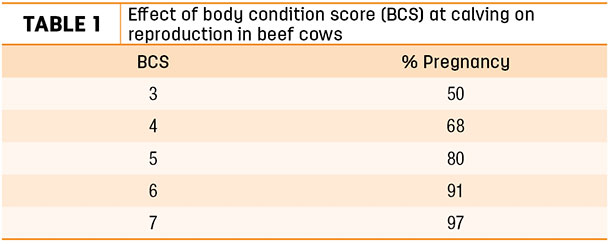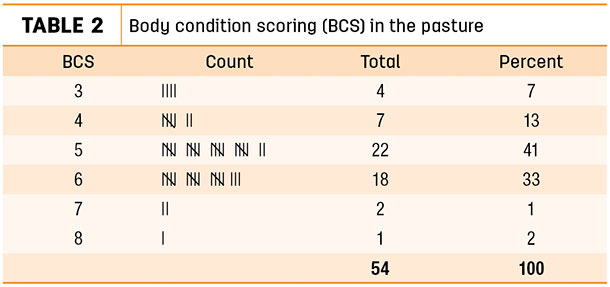Range cattle nutrition is largely dependent on the amount and quality of forage the grazed site can produce. If the number of cattle is correctly matched with the available amount of forage, good animal and range conditions are maintained. If too many cattle are put on a given area, however, animal and range conditions will decline.
Forage quantity and quality
Forage quantity is measurable by several different sampling methods and is expressed as dry matter weight per unit area at a given point of time. For accurate measurement, it is important to only collect samples representative of the range site or vegetation types. The Natural Resources Conservation Service originated the term, “range site.” They define the term as principal units of rangeland based on categorizing vegetation according to site potential. Site potential is defined as the capacity of an area to support a distinct species composition and/or total biomass.
“A common method of measuring forage quantity is to lay a measured size of frame or hoop on the ground in a representative number of areas and clip the enclosed forage. The sample is weighed and the necessary math is used to calculate pounds of forage per acre,” says Dr. Doug Tolleson, Texas A&M AgriLife Research.
New technologies for measuring forage quantity, such as the Livestock Early Warning System (LEWS) are in development. LEWS has been implemented in East Africa and is now undergoing adaptation for use in the U.S. The model will provide early warning of drought to give producers time to reduce stocking rates or make other appropriate management decisions. Field sampling provides the platform for the model, and range condition is further monitored using satellite imagery.
“The other side of the grazing equation is forage quality, which is the amount of nutrients in the forage. Nutrients include protein, energy, vitamins and minerals,” Tolleson continues. “There is a relationship between vegetative characteristics and diet quality. New foliage is more nutritious than old foliage and live plants contain more nutrients than dead plants. More nutrients are found in plant leaves than stems. If available, cattle will primarily choose the higher-quality plant leaves, but will also eat some stems for bulk and roughage.”
Cattle select what they eat based on plant preferences categories. These categories are performance, maintenance, subsistence and toxic. Performance is provided by plants preferred by the animal. They are found in the cow’s diet at a higher percentage than found on the landscape. These plants have a high nutrient content and meet animal needs.
“When the number of desirable plants is about equal with the number of less desirable, the cow goes into a maintenance category. Less desirable plants give bulk to the diet. A cow enters into a subsistence category when less desirable plants outnumber desirables,” says Tolleson. “In the toxic category, undesirable plants substantially outnumber desired plants, and the animal might have to consume plants harmful to its health.”
Animal nutrition
Animal nutrient requirements vary with growth and reproduction stages. A cow needs a certain amount of nutrition to maintain her body. There are additional nutrient requirements for a pregnant animal, and the highest nutrient requirement is found in lactating females. Young animals require additional nutrition for growth, and cattle need a more nutrient-rich diet during cold weather to maintain body heat.
Another reason nutritional requirements are high during lactation is that cows are also trying to rebreed during that period. Effects of body condition scores (BCS) on pregnancy rates are fairly constant across the country and examples are shown in Table 1.

If body condition scores of 8 and 9 were shown in the table, pregnancy rates would start to decrease because fat cattle normally don’t breed well. Likewise, BCS 1 and 2 are not shown because cows in these body conditions have very low conception rates. Their diets are utilized to keep them alive.
“At BCS 1-4, cows are in thin condition,” says Dr. Dan Eversole, Virginia Tech. “They appear angular and bony with minimal fat over the backbone, ribs, hooks and pins. In addition, there is no visible fat around the tailhead or brisket. Cows in ideal condition will have a BCS between 5 and 7. At BCS 5, the animal has visible hips, although there is some fat over the hooks and brisket.
The backbone is no longer visible. Fleshy cows without visible ribs fall between BCS 6 and 7. They also have fat around the tailhead and brisket. BSC 8-9 indicate overconditioned cows. They are smooth and boxy with undistinguishable bone structure, neither by sight nor feel. Large protruding fat may occur around the tailhead and on the pin bones.”
It is easier to maintain animal body condition when their nutrient requirements are matched with range forage quantity and quality. Nutrition controls body condition and body condition governs animal performance, so body condition scoring is an effective and easy method for evaluating the nutritional status of an animal.
Tolleson suggested taking a pocket notebook when checking cattle and entering the table shown in Table 2.

When observing an animal, put a tick mark in the table by their BCS. When returning to the office, the tick marks are counted for each BCS, and the percentage of animals in each category are calculated. In the Table 2 example, the average BCS for the herd was 5.19, with 20% of the animals receiving a sub-optimum score. These types of data can aid in determining whether management changes are appropriate or whether to cull animals with undesirable body condition scores. While evaluating BCS of cattle, one can also observe fecal pats as a means to determine animal nutrition needs.
“Manure scoring indicates quality of nutrition a cow received in the past one to three days, whereas BCS signifies the nutritional history of the past several weeks to months. Manure is scored from 1 to 5 with 1 being very fluid and 5 extremely dry and segmented,” says Dr. Robert Wells, Noble Research Institute. “Score 1 has cream soup consistency and can indicate a sick animal or a highly digestible ration containing excess protein, carbohydrates or minerals and low fiber.”
When manure pats score 2, the cow’s diet contains greater than 20% crude protein (CP) and greater than 68% percent total digestible nutrients (TDN). The pat doesn’t stack, is usually less than 1-inch thick, lacks consistent form and has the consistency of cake batter. Manure score 3 is ideal and occurs when the cow’s diet consists of 12% to 15% CP and 62% to 70% TDN. At this score, the pat typically starts to take on a normal form and has a consistency similar to thick pancake batter. It has a slight divot in the middle and is deeper than a score 2 pat, but will not stack.
“Score 4 manure is thick and somewhat deeper than score 3 pats, yet it is not stacking. Consistency is equivalent to peanut butter,” Wells continued. “This score indicates a lack of degradable rumen protein, excess low-quality fiber or not enough carbohydrates. The highest and least desirable score is 5. The manure is firm, stacks over 2 inches in height, has clearly defined segments and is very dry. This score indicates the cow is eating a poor-quality forage diet inadequate in protein and carbohydrates and high in low-quality fiber.”
Timely monitoring forage quantity and quality, plus regularly observing animal BCS and manure characteristics, helps determine if cattle are receiving adequate nutrition.







